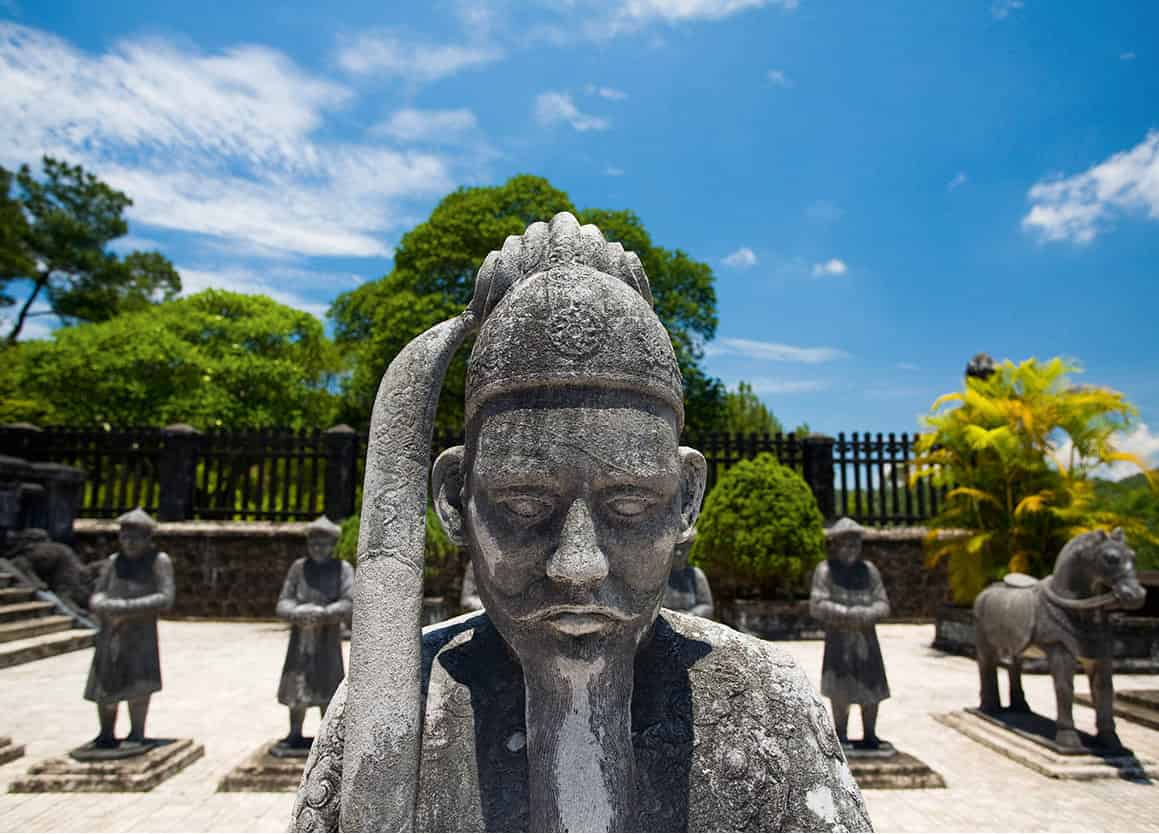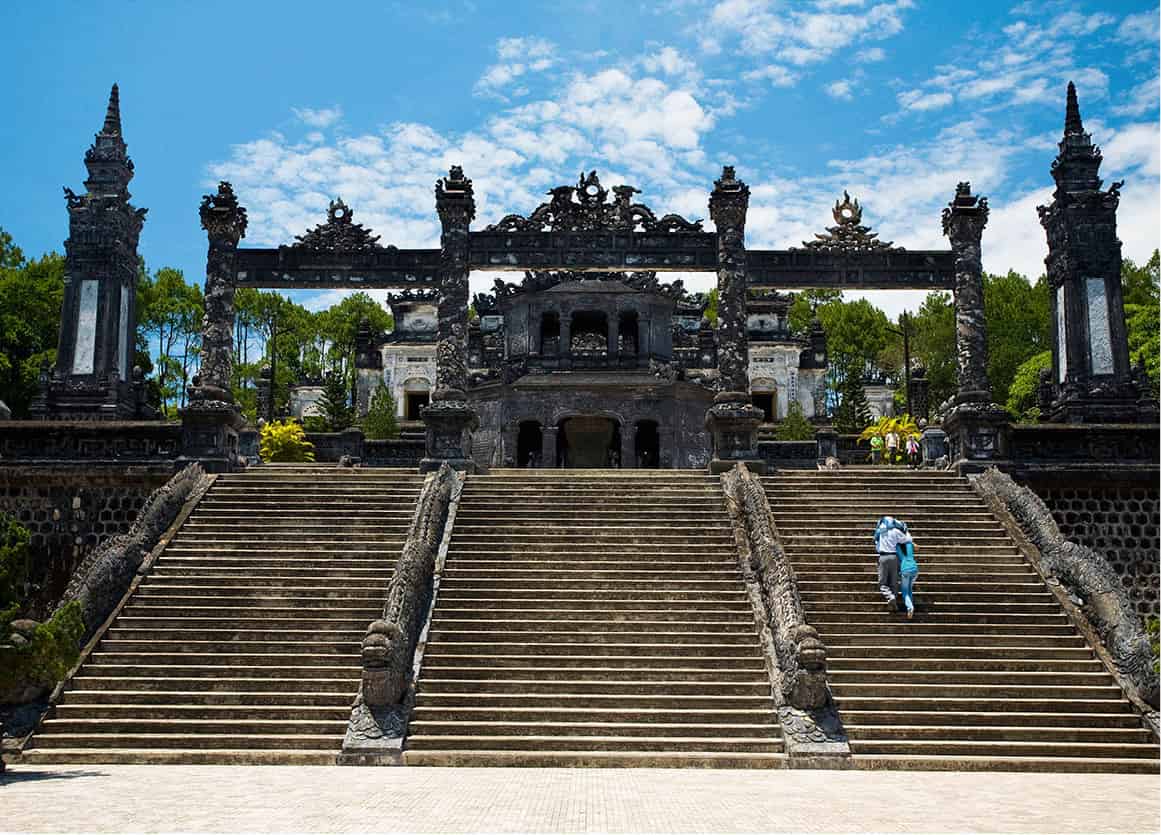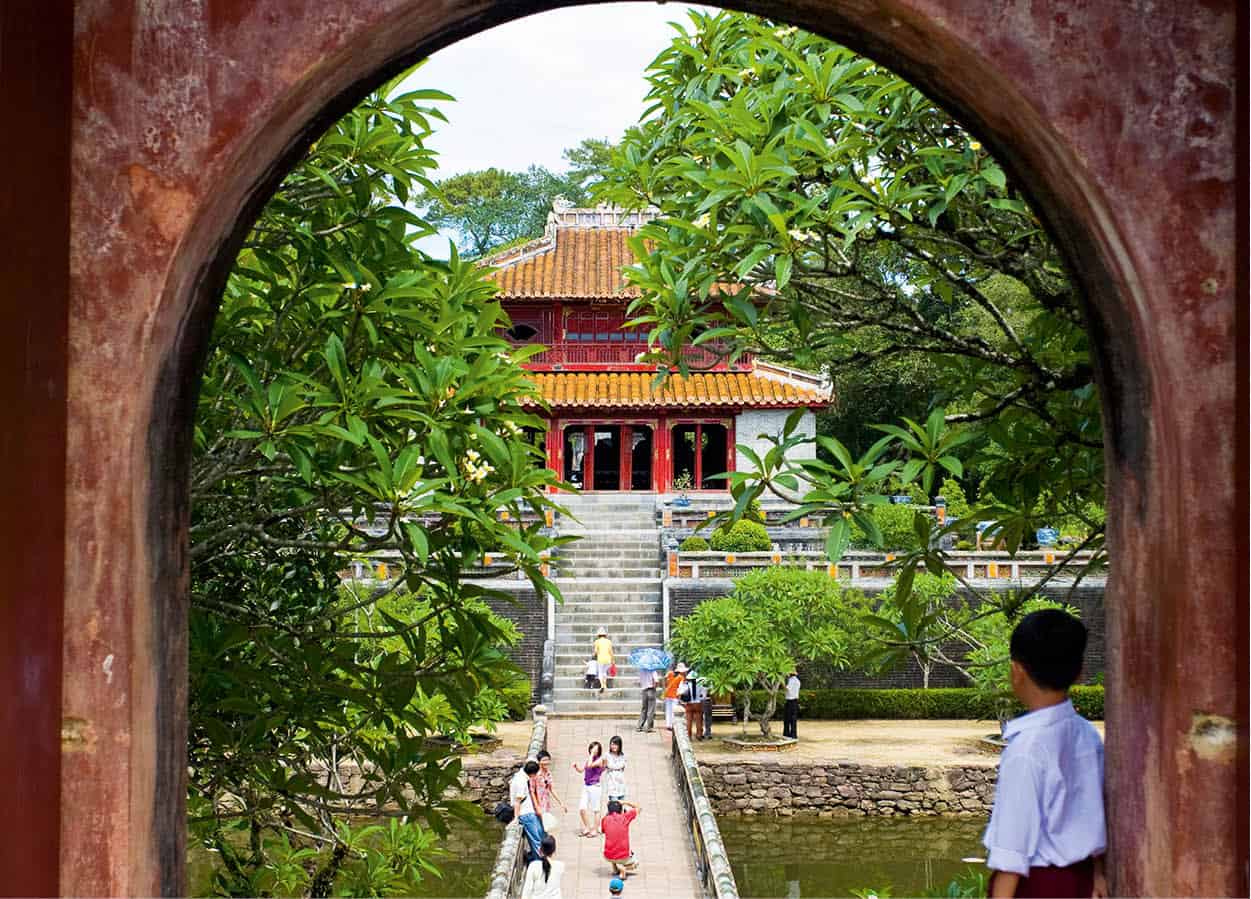DISTANCE: 32km (20 miles)
TIME: A full day
START: Tu Duc’s Tomb
END: Nam Giao Dan
POINTS TO NOTE: Plan to eat before or after the route, or else buy a picnic lunch from La Boulangerie Française (see route 10). This route can be completed by a combination of car, motorbike or bicycle and boat.
The tombs of the Nguyen kings lie scattered on the hillsides along either side of the Perfume River, to the west and south of Hue. Although the dynasty had 13 kings, only seven of them reigned until their deaths, and only they are laid to rest in this valley of kings: Gia Long, Minh Mang, Thieu Tri, Tu Duc, Kien Phuc, Dong Khanh and Khai Dinh. Roads are marked with signs to the tombs. There’s no one correct way to see the tombs, so if you choose to see most of them, it may require some backtracking.
Tu Duc’s Tomb
Follow Bui Thi Xuan West along the Perfume River turning left (south) at the sign for the imperial tombs. The tomb of Tu Duc 1 [map] is the first you will encounter, and surrounded by an onslaught of incense and souvenir shops. The mausoleum construction, begun in 1864, took three years to complete. The result resembles a royal palace in miniature and harmonises beautifully with the natural surroundings. It is perhaps the loveliest of all the Nguyen tombs and the most visited. Live traditional music is periodically performed within the tomb grounds each day for the benefit of visitors.

Stone statues at the tomb of Khai Dinh
Peter Stuckings/Apa Publications
Tu Duc, the son of Thieu Tri and the Nguyen Dynasty’s fourth king, reigned for 36 years, the longest reign of any of the Nguyen kings. He spent his leisure hours in the two pavilions beside the lake, Luu Khiem, where he wrote poetry, no doubt inspired by the beauty of his surroundings, and often went fishing. Xung Khiem is the more interesting of the two lakeside pavilions. A staircase leads to the Luong Khiem mausoleum, which contains a collection of furniture, vases and jewellery boxes. Further on is the terrace leading to the tomb, with its stone elephants, horses and mandarins. The tomb itself, ritually inaccessible, is covered by dense pine forest. The tombs of Tu Duc’s adopted son, Kien Phu, and Queen Le Thien An, lie beside the lake.
Thieu Tri’s Tomb
The tomb of Thieu Tri 2 [map] (daylight hours; charge) is located a few kilometres to the south along the Perfume River. Thieu Tri, Minh Mang’s son, was the third Nguyen emperor and reigned from 1841–7. His tomb was built in the same elegant architectural style as his father’s but on a much smaller scale, and is now crumbling. The mausoleum sprawls across several lakes and is largely open, without the surrounding walls found around other tombs.
Minh Mang’s Tomb
The tomb of Minh Mang 3 [map] (daily 8am–5pm; charge) is located about 5km (3 miles) south, where the Ta Trach and Huu Trach tributaries of thePerfume River meet. Turn left (east) at the overpass and take the bridge across the river.
Minh Mang was Gia Long’s fourth son and the Nguyen Dynasty’s second king. Construction of the tomb was begun a year before Minh Mang’s death in 1840, and was finished by his successor Thieu Tri in 1843. The setting blends the beauty of nature with the majestic architecture and superb stone sculpture created by its many anonymous craftsmen. It is at its best in mid-March, when the Trung Minh and Tan Nguyet lakes bloom with a mass of beautiful lotus flowers.
Now would be a good time to break for a picnic lunch or head back into Hue and resume the rest of the tour tomorrow.
Minh Mang was responsible for the construction of the Imperial City of Hue. He was highly respected by the Vietnamese for his reforms in the areas of customs, traditions and agriculture. However, he is disliked to this day by the Cham, as the Vietnamese ruler who dealt the last blow to the declining Champa Kingdom.

Dragon staircase in front of Khai Dinh’s tomb
Peter Stuckings/Apa Publications
Gia Long’s Tomb
The tomb of Gia Long 4 [map] (daily 8am–5pm; charge) is located 16km (10 miles) south from Hue. To get there from Minh Mang’s tomb, cross back over to the east side of the river, head south for at least 1km (0.6 mile), and stop at the nearest boat landing to be ferried across to the tomb. The tomb sits on a hillside, and is inaccessible by road. The tomb, begun in 1814, was completed a year after Gia Long’s death in 1820. Unfortunately, the site was in the middle of a guerrilla zone during the Vietnam War, and the tomb was considerably damaged by bombs. The tomb has been rather neglected, but the wild beauty of the site itself, with its mountainous backdrop, makes the effort to get there well worth the time.
Khai Dinh’s Tomb
About 3km (2 miles) back across the river and north on Road 49, the tomb of Khai Dinh 5 [map] (daily 8am–5pm; charge) somewhat resembles a European castle, its architecture a blend of the oriental and occidental. Made of reinforced concrete, it took 11 years to complete and was finally finished in 1931. Khai Dinh, Bao Dai’s adopted father, ruled for nine years during the colonial era. A grandiose dragon staircase leads up to the first courtyard, from where further stairs lead to a courtyard lined with stone statues of elephants, horses, and civil and military mandarins. In the centre of the courtyard stands the stele inscribed with Chinese characters composed by Bao Dai in memory of his father. The exterior lacks the tranquil charm and beauty of Minh Mang’s or Tu Duc’s mausoleum, and the giant dragons flanking the staircase appear rather menacing.
Once inside, however, the contrast is striking and more identifiable with the ostentatious character of the emperor. Coloured tiles pave the floor, and a huge ‘dragon in the clouds’ mural, painted by artists using their feet, adorns the ceiling of the middle chamber. Bright frescoes composed of many thousands of inlaid ceramic and glass fragments depict various themes. Animals, trees and flowers provide a visual feast after the morbid, blackened exterior of the mausoleum. The back room contains a small museum of the emperor’s possessions, including photos, clothing, ceramics, crystal, furniture and a clock. A life-size bronze statue of Khai Dinh, made in France in 1922, rests on a dais on top of the tomb.

The tomb of Minh Mang
Peter Stuckings/Apa Publications
Nam Giao Dan
Head about 4km (2.5 miles) south on Dien Bien Phu (also known as Minh Mang Street or road 49 here) to Nam Giao Dan 6 [map] (Terrace of Heavenly Sacrifice; daylight hours recommended; free), an esplanade surrounded by a park of pines and conifers and one of the less visited of Hue’s attractions. Built by Gia Long in 1802, in its day it was considered a very sacred and solemn place. Composed of three terraces – two square and one circular – the esplanade represents the union of sky and earth. Every three years the Nam Giao (Festival of Sacrifice) took place at the centre of the circular platform. From here the emperor, worshipped as a god himself, would have a buffalo sacrificed to the god of the sky, who is believed to govern the destiny of the world.
With today’s tour finished, head north 2km (1.5 miles) on Dien Bien Phu, then right on Le Loi to Hue’s commercial centre for dinner at La Carambole, see 1, or Tropical Garden, see 2.
Food and drink
1 La Carambole
19 Pham Ngu Lao; tel: 054-381 0491; daily B, L & D; $$$
La Carambole has a festive atmosphere with a packed house in the evenings. The menu includes English, French and Vietnamese favourites. Try the quiche and the home-made lemon sorbet. The staff’s English is good and the service is fast. There is now the Jardins de la Carambole sister restaurant across the river, a more upmarket take on the original.
2 Tropical Garden
27 Chu Van An; tel: 054-384 7143; daily B, L & D; $$$
An unashamedly tourist-focussed option, Tropical Garden serves traditional Hue cuisine with a traditional four-piece orchestra from 6–9pm nightly. Try the set menus or just come for ice cream and music. Sit in the garden by the street or inside the bamboo enclosure.
